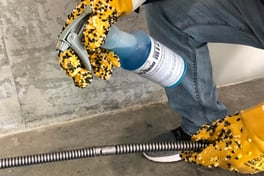Protect your investment by properly caring for your tools
Drain cleaning is a tough job; you need equipment that works and is reliable. Regular cleaning and maintenance is the key to ensuring your equipment is ready to go when you need it. But too often, drain cleaners and plumbers let busy schedules get the best of them. Before you know it, you’ll have equipment that needs an expensive repair or even replaced.
Understanding common problems and learning how to prevent and address them can save you both time and money in the long run. Here is a brief guide to proper maintenance of your drain cleaning equipment.

Keep it clean
Replacing worn or damaged parts is straightforward — the daily grind of clean up and logging damage is where many drain cleaners fall short. When you don’t clean your equipment regularly, you set yourself up for some major problems. First, sewage corrodes metal, weakening your cable or hose as well as reels and frames. This makes your entire machine more prone to breakage and failure. Not cleaning your camera head is also risky. Sewage can corrode the spring or camera body, making it thin or brittle, while pockmarks allow water to enter the camera head causing a short.
Check the hose/cable/push rod
One of the most common equipment problems drain cleaners face is a kinked cable or push rod, or damaged jetter hose. It is important to regularly inspect these components as you feed or rewind, and repair or replace at the first sign of damage or fatigue.
Protect your power source
Another major issue for drain cleaners and plumbers is damaged wiring or broken or missing ground prongs or GFCI connections. Aside from the personal risk of electrocution, frayed wiring can also damage your equipment. It can lead to spikes in current, causing heat damage to internal components like chips and drives. A small nick in a power cord can cook all of the internal components of your camera system, turning a small problem into a very expensive repair. In addition, insufficient power can cause your system to run sluggishly. Slow, struggling equipment is the last thing you need when trying to clear stubborn blockages.
Use common sense
We see many repairs in our shop that involve preventable damage such as cameras that were used to “ram” obstructions, or pumps that weren’t properly winterized. It may seem obvious but remember to follow the manufacturer’s recommended maintenance. At the very least check oil levels, keep moving parts lubricated, and regularly inspect and clean.
Dedicate 10 minutes at the end of every day to care for your equipment and replace damaged parts quickly. With this process in place, you can feel confident going to work each day knowing your equipment will be ready to go. Additionally, MyTana stocks repair items for all our equipment It’s a benefit of purchasing your equipment factory-direct, and we’re happy to answer any questions about caring for your investment.
PS – we’ve got a more in-depth guide to jetters and their maintenance you can check out here.
To receive future operations and maintenance tips, product news, and industry updates, subscribe to MyTana’s free email newsletter:




